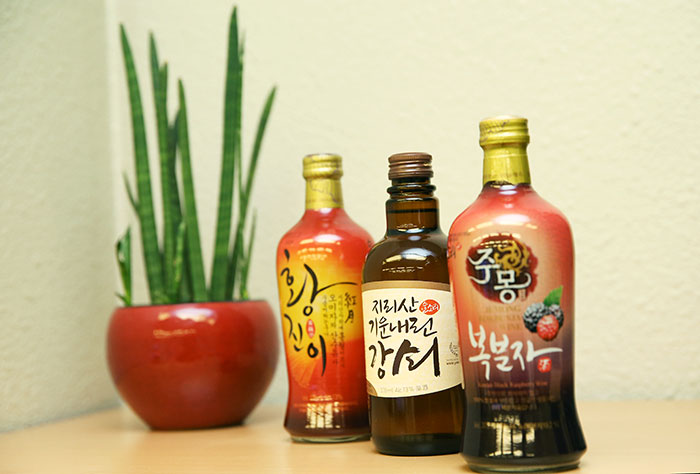The ingredients vary in traditional Korean liquor. There are so many potential ingredients, in fact, that it matches the potential number of liquors themselves.
These ingredients include edible fruits, greens, trees and flowers, all of which add more flavor to each of the traditional beverages. Some of the more popular, commercialized ingredients among them are the Korean black raspberry (bokbunja), Schisandra chinensis berries (omija), Cornus officinalis berries (sansuyu), the stems and berries of Acanthopanax Koreanum (ogapi) and fruit from the Chinese matrimony vine (gugija).
Based in Namwon, Jeollabuk-do (North Jeolla Province), the traditional liquor maker Chharmborn has been making Jumong, Hwangjiny and Gangsoe drinks for many years. Each of these liquors is made from different balances of omija, bokbunja, sansuyu, ogapi and gugija.

Among them, Hwangjiny recently won the top prize in the Korean Liquor Contest 2014, hosted by the Ministry of Agriculture, Food & Rural Affairs. It also won the grand prix of Korea liquor competitions in 2013. It was used as the official drink for toasts during the inter-Korean summit in 2006. It is made from rice and omija and sansuyu grown on Jirisan Mountain and is brewed in a traditional manner. Omija is known to be good for recovering your strength when tired, and it also helps prevent aging and boosts your physical strength. Sansuyu enhances kidney functions. When poured into the glass, Hwangjiny shows off a beautiful red color. It is sweet, soft and refreshing, thanks to the unique omija taste.
If you prefer a sweeter flavor, Jumong would be a good choice. This liquor is made mainly from rice and bokbunja. It received the top prize in the Korean Liquor Contest 2010. Bokbunja is well known for enhancing one's eyesight, preventing aging, boosting blood circulation and increasing stamina. Customers can taste the true taste of bokbunja in this drink, as Jumong is a pure fermented liquor made using a traditional fermentation process that does not add any additional alcohol to the process, such as soju. It has a soft, sweet taste, and does not cause a hangover. This product is exported to Australia, Japan and mainland China.
For those who look for a more "masculine" liquor, Gangsoe would be the one. It is made from fermented rice and malt with Chinese medicinal herbs added, such as ogapi and gugija. Ogapi is known to protect liver and kidney functions, and strengthens bones and the overall physique. Gugija is good for treating hardened arteries, and in preventing dementia, aging, heart disease and the common cold. Made from ogapi and gugija, Gangsoe offers the unique smell and taste of medicinal herbs, which attracts many male customers.
More information about these liquors is available at the company’s website, serviced in both Korean and English (http://yaksul.koreasme.com).
By Yoon Sojung
Korea.net Staff Writer
arete@korea.kr
These ingredients include edible fruits, greens, trees and flowers, all of which add more flavor to each of the traditional beverages. Some of the more popular, commercialized ingredients among them are the Korean black raspberry (bokbunja), Schisandra chinensis berries (omija), Cornus officinalis berries (sansuyu), the stems and berries of Acanthopanax Koreanum (ogapi) and fruit from the Chinese matrimony vine (gugija).
Based in Namwon, Jeollabuk-do (North Jeolla Province), the traditional liquor maker Chharmborn has been making Jumong, Hwangjiny and Gangsoe drinks for many years. Each of these liquors is made from different balances of omija, bokbunja, sansuyu, ogapi and gugija.

(From left) The Charmborn drinks company makes Hwangjiny, Gangsoe and Jumong liquors. These liquors are made from natural ingredients grown on the slopes of Jirisan Mountain. They are made using traditional methodologies, which adds more flavor and aroma, and they are good for your health.
Among them, Hwangjiny recently won the top prize in the Korean Liquor Contest 2014, hosted by the Ministry of Agriculture, Food & Rural Affairs. It also won the grand prix of Korea liquor competitions in 2013. It was used as the official drink for toasts during the inter-Korean summit in 2006. It is made from rice and omija and sansuyu grown on Jirisan Mountain and is brewed in a traditional manner. Omija is known to be good for recovering your strength when tired, and it also helps prevent aging and boosts your physical strength. Sansuyu enhances kidney functions. When poured into the glass, Hwangjiny shows off a beautiful red color. It is sweet, soft and refreshing, thanks to the unique omija taste.
If you prefer a sweeter flavor, Jumong would be a good choice. This liquor is made mainly from rice and bokbunja. It received the top prize in the Korean Liquor Contest 2010. Bokbunja is well known for enhancing one's eyesight, preventing aging, boosting blood circulation and increasing stamina. Customers can taste the true taste of bokbunja in this drink, as Jumong is a pure fermented liquor made using a traditional fermentation process that does not add any additional alcohol to the process, such as soju. It has a soft, sweet taste, and does not cause a hangover. This product is exported to Australia, Japan and mainland China.
For those who look for a more "masculine" liquor, Gangsoe would be the one. It is made from fermented rice and malt with Chinese medicinal herbs added, such as ogapi and gugija. Ogapi is known to protect liver and kidney functions, and strengthens bones and the overall physique. Gugija is good for treating hardened arteries, and in preventing dementia, aging, heart disease and the common cold. Made from ogapi and gugija, Gangsoe offers the unique smell and taste of medicinal herbs, which attracts many male customers.
More information about these liquors is available at the company’s website, serviced in both Korean and English (http://yaksul.koreasme.com).
By Yoon Sojung
Korea.net Staff Writer
arete@korea.kr